|
Lesson 1 Give
Your Child a Manners Makeover
by Cindy Post Senning
Cindy Post Senning, Ed.D. is Emily Posts great-granddaughter, and educator and
author of numerous books on children and manners. The holidays are coming.
Decorations are popping up everywhere. Holiday music is playing in stores.
People are planning turkey dinners. Families will be traveling to visit
families. Parents may be stressing. And kids are beside themselves with
excitement!
Parents ask me, "What can we do? The kids are wild, and we've left table manners
by the wayside. Is it too late?" No, it's not too late to spruce up the manners
you want your children to know before the craziness sets in. You can help them
by practicing a few days before Thanksgiving and Christmas.
Make time to talk with your kids about manners too. Ask them why manners are
important and which ones they think make the most sense. Help them understand
this isn't about "rules," it's really about how we get along with each other.
The goal is to make this a positive experience and then to enjoy the holidays.
Let's get started!

Table Manners
Practice setting a simple table setting with your child: fork on the left, knife
and spoon on the right (knife next to the plate), glass on the right above the
knife and spoon. (Ask your kids for suggestions for table decorations.)
Explain the basics:
-
Wash up.
-
Put your
napkin in your lap.
-
Wait until
all are served or the hostess begins to eat, before starting to eat.
-
Say,
"Please" and "Thank you."
-
Hold
utensils properly.
-
Chew with
your mouth closed.
-
Offer to
help clear.
-
Thank the
cook!
Table Conversation
-
Children
should talk to people beside and across from them.
-
Volume: Not
too loud; not too soft.
-
Don't talk
with your mouth full! (Try putting a mirror in front of your child during a
meal, so she can see how it looks.)
-
The art of
small talk: For older kids, suggest topics like the weather, sports, local
events, school and then practice with them. Use questions that begin with
who, what, where, when and how.
-
Talking
about personal family issues is a no-no!
-

Greetings and Handshakes
Kids can practice with siblings, neighbors, dolls and stuffed animals!
Greetings - The most important thing for them to do is to look the person in the
eye and SMILE! They should also:
-
Speak
clearly.
-
Say the
person's name.
-
Add a "Glad
to see you" or "How's it going?" If it's a relative or close friend, add a
hug.
Handshakes - In the olden days, knights extended a hand to show it did not hold
a weapon. The other person responded showing he didn't have a weapon either.
Today, kids should simply remember:
-
Right hand
to right hand
-
Firm grip -
not too tight; not too limp
-
Two to
three pumps
-

Gifts You Don't Wrap
Some of the best things we can give at the holidays can't be wrapped. By talking
with your children about this concept, you'll raise their consciousness about
these special gifts: kindness, consideration and helping out.

Giving and Receiving Gifts
Help your kids learn the gracious art of gift giving and receiving.
Gift Giving - In order to help your kids learn the joy of giving, involve them
in gift shopping or making the gifts they'll give. Then practice these
interactions:
-
Look at the
person and smile.
-
Hand them
the gift and say clearly, "This is for you. I hope you like it." Or "Here, I
made this especially for you."
-
Watch the
person open their gift and feel the delight that comes with giving.
Gift Receiving - Remind kids that time and thought went into picking out their
gift. It's important to be polite by opening the gift with a sense of joy and
then expressing thanks. Have your child:
-
Look at the
person giving the gift and smile.
-
Focus on
the person and the gift - not something that was opened just before.
-
Say a big,
"Thank you!" You can't stress this enough with your children! If they can't
thank the giver in person, send a note right away!
If they don't like the gift, teach them to find something positive to say, to
say it, and then to say "Thank you." For example, "This shirt is the best color
blue. Thank you so much."
I
hope these tips will help you and your child. And remember, good manners are a
gift that will last a lifetime!


Lesson 2 Fish
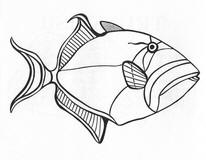 TRIGGERFISHThe
triggerfish is named for the large strong spine on its back. This makes it less
likely to become dinner for larger fish. Imagine trying to eat a board with a
nail sticking out of it! A favorite food of some triggerfish is the spiny sea
urchin, an animal that looks like a purple pincushion. To avoid hurting itself
while dining on such a treat, the eyes of the triggerfish are not on the front
of its face, but instead back where its ears should be. TRIGGERFISHThe
triggerfish is named for the large strong spine on its back. This makes it less
likely to become dinner for larger fish. Imagine trying to eat a board with a
nail sticking out of it! A favorite food of some triggerfish is the spiny sea
urchin, an animal that looks like a purple pincushion. To avoid hurting itself
while dining on such a treat, the eyes of the triggerfish are not on the front
of its face, but instead back where its ears should be.
 BUTTERFLYFISH BUTTERFLYFISH
This fish
is named for its bright colors that sometimes look much like those on the wings
of real butterflies. Like its larger cousin the angelfish, the butterflyfish is
seldom seen in groups. Instead, it prefers to travel alone or in pairs. The long
slender jaws and tiny teeth allow the butterflyfish to nibble at small animals
that live int he reef. Many butterflyfish have stripes through the eyes and a
large spot near the tail, making it difficult to tell which way this fish is
really facing!
 This
guy eats corals This
guy eats corals
PARROTFISHThis
fish is named for its bright colors and strong beak-like jaws, which it uses to
bite off chunks of coral. Parrotfish then grind the rocky coral into a fine
sand, and eat the tiny plants and animals that live within. If you swim about on
a coral reef you will hear them going CRUNCH! CHRUNCH! CHRUNCH! all day long.
Much of the sand found around reefs is really coral that has been crushed by
parrotfish. Parrotfish change color as they grow, with the largest and brightest
fish being the oldest.
ANGELFISH
Baby 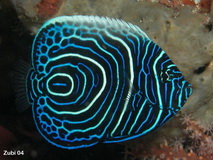 grow to become
like this
grow to become
like this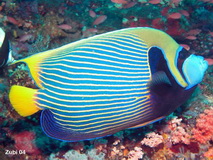
The
angelfish is without doubt one of the most beautiful fish found on coral reefs.
A living rainbow, it is a favorite of photographers and fishwatchers alike.
Angelfish spend most of the time cruising gracefully around the reef feeding on
the sponges and plants that live there. Their pancake-shaped bodies allow them
to turn quickly. They are so thin and flat that they seem to disappear when they
turn to face a diver.
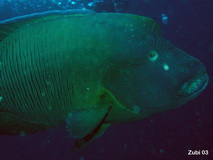 Napoleon
wrasse Napoleon
wrasse
WRASSE
The colorful wrasse is a close cousin of the parrotfish. There are many
different kinds of wrasses found on coral reefs. Most are small, but a few grow
to more than seven feet. Some wrasses play a special role in the coral city.
These are called "cleaners" because they eat unwanted animals that have attached
themselves to the bodies of other fish. When being cleaned, the wrasses's
customers will even open their mouths and allow the wrasse to swim in without
danger of being eaten! At night, you will seldom see a wrasse on the reef
because they bury themselves in the sand to sleep
GROUPER
The slow moving grouper is a sly hunter. It catches other fish by waiting in
ambush, and then suddenly darting forward to swallow its victim in a single
bite. Some groupers grow to more than ten feet and over five hundred pounds.
With their large seize, groupers eat just about any fish that carelessly strays
too close. Because they are delicious themselves however, groupers often end up
on the menus of seafood restaurants.

Lesson 3 Famous People
WHO ARE THE FOLLOWING PEOPLE ?
1. Marco Polo
2. Vasco Da Gama
3. Christopher Columbus
4. Ferdinand Magellan
5. Captain James Cook
6. David Livingstone
7. Roald Amundsen
8. Genghis Khan
9. Edmund Hilary

Lesson 4 Mola Mola
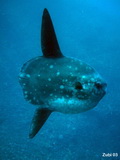 (see
comparison of sunfish with the size of a human) (see
comparison of sunfish with the size of a human)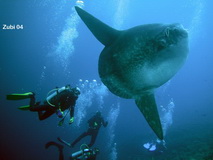
CHORDATA (VERTEBRATES)
Sunfishes (Molidae)
The word "Mola" comes from Latin and means millstone.
The ocean sunfish (Mola mola) is the worlds largest known bony fish (whale
sharks are cartilaginous) with about 3m length from fin tip to fin tip and
weighting 2 tons
The family of Molidae belongs to the order of Tetraodoniformes (trigger fish,
boxfish, porcupine fish, puffers).
They consists of six species: Mola mola (ocean sunfish), Masturus
lanceolatus (Sharptail mola) and
Ranzania laevis (Slender sunfish),
Mola ramsayi (southern sunfish),
Amblypharyngodon atkinsonii
and Amblypharyngodon mola.
Specially the ocean sunfish (Mola mola) has a very unmistakable look with its
eccentric roundish shape with huge fins but nearly no discernable tail.
Characteristics
Their characteristic body shape is unique and is about the most peculiar sight
you might encounter while diving. They seem to have no caudal fins at all (this
rudder-like structure is called clavus), the body is large and flattened and
their eyes and mouth are very small. They possess sharp edged plates of fused
teeth in the jaws, which are typical of puffer fish. The scaleless body is
covered with a tough, leathery skin about 15cm thick. Silvery to brownish gray
or a blue motteled colour. The gill openings are small and just behind them are
the small pectoral fins. The dorsal and anal fins are large and look like
paddles. They are flapped synchronously from side to side (like the triggerfish)
and can propel the fish at surprisingly good speed. Adults have no swimbladder.
Ecology and range
Sunfishes are found in all oceans in tropical and temperate climes, but prefer
open ocean. They are adapted for life as a sluggish, pelagic predators of
jellyfish or other larger invertebrates that come close enough to be sucked in.
Probably they inhabit the mesopelagic zone down to about 1000 meters, but live
most commonly about 300m deep.
Behavior
Molas are
considered to be among the most fecund of all vertebrates, producing more that
300 million eggs, each about 2 to 3mm large. The larvae look much more like
their close relatives, the puffer or porcupine fishes with needlelike spikes. As
they grow their body flattens and the spines and their tails disappear.
Molas have a
very small mouth that they can't close and they posses a parrot-like beak formed
by sharp edged plates of fused teeth. This is also typical of puffer fish.
Mola mola eat a
variety of foods, but mostly gelatinous zooplankton (jellyfish and salps) as
well as squid, sponges, serpent star, eel grass, crustaceans, small fishes and
deepwater eel larvae. Molas forage both at the surface, among floating weeds, on
the sea floor and in deep water. They are well adapted to eat jellyfish because
their thick skin provides armor against the stinging barbs. Ocean sunfish render
their prey into bite-size pieces before ingesting the morsels by sucking in
their prey and spitting it out again. They have long, claw-like teeth in their
throat.
Molas are not
highly desirable as food, since their meat may contain the same toxin as puffers
and porcupine fish. The sunfish can probably get over 100 years old.
The common
sunfish, Mola mola, are often covered with parasites. Some 40 different genera
of parasites have been recorded on this species alone. To get rid of these them
they approach drift kelp and other flotsam to recruit small fish living there to
clean them.
In southern
California the sunfishes surface and seagulls pick these parasites off them.
They often drift at the surface while lying on their side, or swim upright and
close to the surface that their dorsal fin projects above the water like a large
shark fins. Here Molas are also commonly observed jumping out of the water.
In
Bali the Mola Mola come relatively close
to the reef to certain cleaning stations where groups of the bannerfish (Heniochus
diphreutes) literally "attack" them, eating the parasites that infest their
skin. If a sunfish comes even closer to the reef, angelfishes and sometimes
other butterflyfishes also go after the parasites.

Lesson 5 Dinosaurs
Age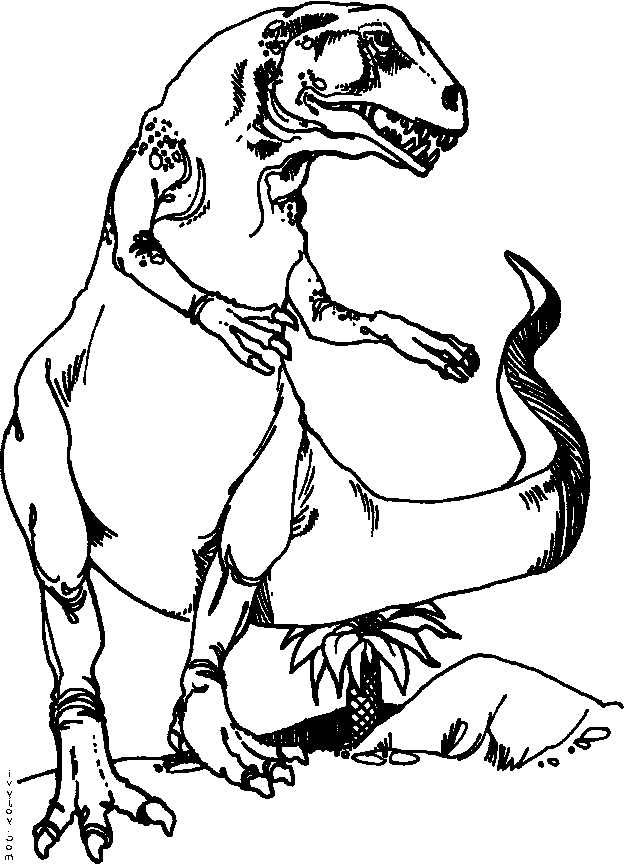
Here is a part of the "Staircase
of Time" showing when the dinosaurs lived.
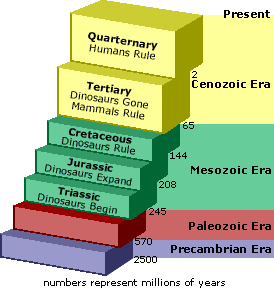
Dinosaurs appeared on Earth nearly 250 Million years ago, early
in a period of time geologists called
Triassic.

They grew in numbers and types during the
Jurassic time period.
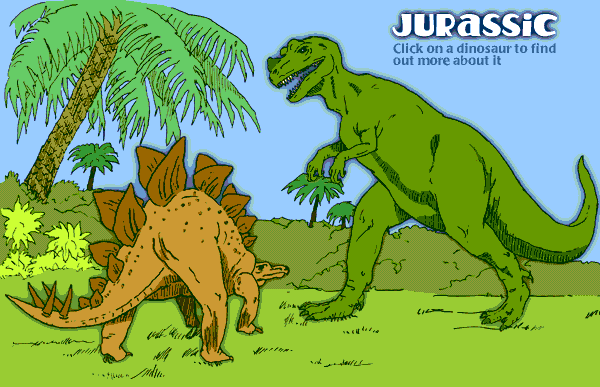
They dominated Earth during the
Cretaceous time period.
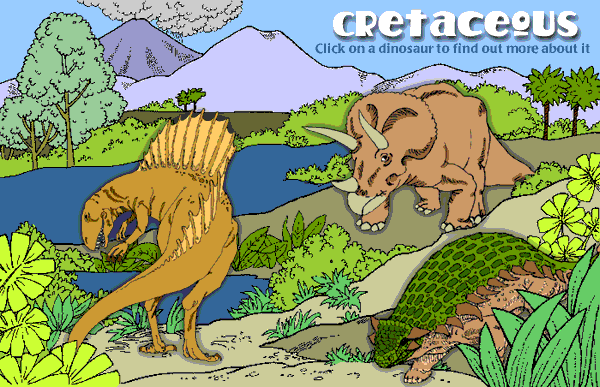
Their feet shook the ground for nearly 200 million years - 40,000
times as long as recorded human history! But then suddenly they all mysteriously
disappeared at the end of the Cretaceous Period about 65 million years ago. Why?
Giant Volcanic Eruptions
In this alternate explanation of the loss of the dinosaurs, they did not die out
in an instant in some catastrophic disaster, but over a period of a few million
years of very stressful conditions. These conditions were caused by a series of
giant volcanic eruptions that lasted for a long time --several million years, in
fact. Even in our time, large volcanic eruptions have been known to change our
weather--mostly by dumping vast amounts of sulfur into the upper atmosphere. The
sulfur changes into droplets of sulfuric acid which are bright and reflect away
the light of the Sun before it reaches and warms Earth's surface. Consequently,
the temperature on the surface of Earth drops somewhat. Even a relatively small
eruption like that of Mount Pinatubo in the Philippines (pictured at the top of
this page) put enough sulfur into the air to cause a measurable drop in
temperature world-wide.
This graph of the Earth's average temperature changes since 1950
shows many ups and downs, but the trend since about 1960 has been constantly
upward. (Many people think that is the result of Global Warming, but that is
another story!) Notice the big drop that lasted for about three years starting
in 1991. That is the effect of the eruption of Pinatubo. The drop is only about
half a degree, so most people didn't notice it. But this change was caused by
only one fairly small volcanic eruption!
In 1815, a much larger eruption occurred at Tambora in Indonesia.
This single volcano put enough sulfur into the air to cause several degrees of
cooling. Enough to cause crop failures and starvation in France and northeastern
United Stated in 1816 and 1817!
What happened to the dinosaurs? Imagine an endless series of
super-Tamboras erupting every few decades or centuries. Remember, hot-spot
eruptions are hundreds and thousands of times larger than even Tambora-size
eruptions. The result would be irregular periods of great cold every few decades
or centuries. Some scientists think that the eruptions poured enough carbon
dioxide into the air to cause long-term warming, so that the weather would be
alternating periods of unusually hot and cold weather. Plants in different areas
of the land would die, not all at once, but during the long periods of poor
weather. The excess carbon dioxide might also have poisoned the oceans, causing
marine plants and animals to die. When the plants died,
the local plant eaters like triceratops and brachiosaurus soon died also,
followed by the meat eaters like T-Rex. Animals would be forced to
migrate or die. And often they died anyway.
Eventually, the eruptions stopped and the weather returned to
normal. But before that happened, many of the Earth's plants and animals,
including the dinosaurs, were gone.
But now, the question is is there any evidence that this is how
the dinosaurs died? There is an appropriately huge volcanic deposit that formed
at the right time: the Deccan Traps in India. You might look up more information
about volcanoes, the Deccan Traps, or "hot spot" volcanism. Or watch a volcano
erupt. What about the fossil record? Did the dinosaur fossils end all at once,
or do they slowly fade out over a period of time? Is there any evidence of
climate change or stressed animals? There is much you can look for to test this
alternate explanation. Good Luck!
The Age
of Humanity
The Earth is covered with people! Humanity Rules! Our cities, roads, and farms
blanket the land! Our ships criss-cross the seas! Our airplanes fill the skies!
We are even entering the depths of space! We stand at the top of the "Staircase
of Time."
But
time continues to pass.... What's this? A new step is forming at the top of the
Staircase: The Future!

Lesson 6
Dinosaurs
CERATOPS
The "horned faced" Triceratops and Torosaurus are often pictured in a fight with
a Tyrannosaurus rex. Fossils of these dinosaurs
have been found from Mexico to Canada in North America. They do not appear to
have lived on the other continents. Fossils of the "horned faced" dinosaurs
measure from 5 to 30 feet in length. A Triceratops would have been a very
powerful animal. It would have been able to defend itself with its long horns
and powerful body. The "horned faced" dinosaurs were ornithischian plant eaters
which lived in the
Cretaceous Era.
http://www.cotf.edu/ete/modules/msese/dinosaurflr/cretaceous/ceratops.html
SPINOSAURUS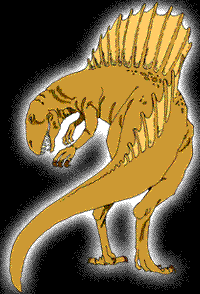
The "thorn lizard" Spinosaurus was a theropod dinosaur which lived in the
Cretaceous Era. It was about 50 feet long, and its fossils have been found
in both northern Africa and southern Asia. Spinosaurus had a large sail-fin on
its back, but no one knows why. The sail may have been used to catch the warmth
of sunlight, to frighten enemies, or to attract a mate. Spinosaurus may have
weighed more than 4 tons.
http://www.cotf.edu/ete/modules/msese/dinosaurflr/cretaceous/spinosaurus.html
ANKYLOSAURUS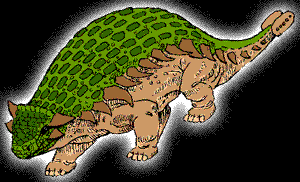
The "fused lizards" Euoplocephalus and Ankylosaurus had body armor. These
dinosaurs were "bird hipped" ornithischians that ate plants which lived in the
Cretaceous Era. These dinosaurs and their relatives could grow more than 40
feet long, but many were shorter than 20 feet. Fossils of these dinosaurs can be
found in northern USA and in Canada. Fossils of "fused lizards" have been found
in China.
http://www.cotf.edu/ete/modules/msese/dinosaurflr/cretaceous/ankylosaurus.html
CERATOSAURUS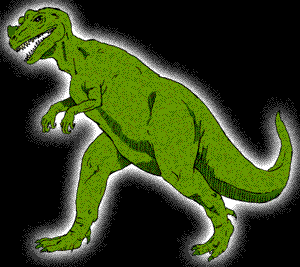
This
Jurassic theropod dinosaur was a big creature, growing to as long as 20
feet. Found in North America, Europe, Asia, and Africa, it belongs to a family
called the "horned lizards" (Ceratosauridae). It had strong arms that ended in
four-fingered hands, indicating that it was a primitive dinosaur. Another
interesting feature of this dinosaur was its fused hip and foot bones similar to
those found in birds.
http://www.cotf.edu/ete/modules/msese/dinosaurflr/jurassic/ceratosaurus.html
STEGOSAURUS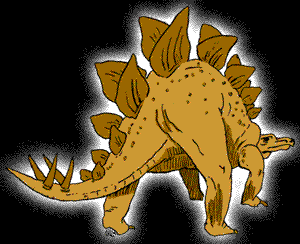
Almost everyone is familiar with the Stegosaurus, a four-legged herbivore from
the
Mid-Jurassic to the
Late Cretaceous time. Its two rows of bony plates and tail spikes probably
provided it much protection against large predators like Tyrannosaurus rex. Some
people have guessed another purpose for the plates. A closer look at the
fossilized plates reveals small grooves which may have held blood vessels which
the Stegosaurus may have used to rid itself of excess body heat. In this sense,
the plates were probably a form of heat-exchanger, giving off or taking on heat
as the dinosaur needed. This dinosaur grew to about 30 feet, and it may have
stood on two legs to reach high vegetation. Fossils of Stegosaurus have been
found in western United States, in Europe, in eastern, southern Africa, and in
Asia, particularly in southern India and in China.
http://www.cotf.edu/ete/modules/msese/dinosaurflr/jurassic/stegosaurus.html
STAURIKOSAURUS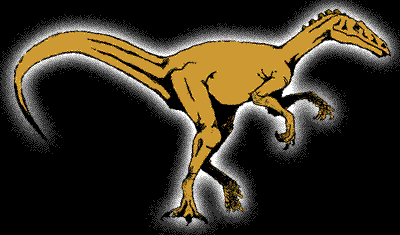
This Triassic dinosaur belonged to the Staurikosauridae family ("Southern Cross
lizards" named after the star constellation seen in the Southern Hemisphere).
Living in both North and South America during the middle to late
Triassic, this six-and-a-half-foot dinosaur was probably as heavy as a human
adult. It had large, sharp teeth, and it may have been the very first dinosaur
to be able to attack bigger animals. No one has determined if this dinosaur was
a theropod or a saurischian. It appears to be a primitive dinosaur.
http://www.cotf.edu/ete/modules/msese/dinosaurflr/triassic/staurikosaurus.html
ANCHISAURUS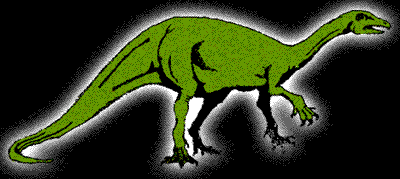
Anchisaurus was a
Middle Triassic to
Early Jurassic plant-eater about 7 to 10 feet long. It had five-fingered
hands with a curved thumb claw, and its feet had five toes. Achisaurus had
spoon-shaped teeth that were probably not used for chewing food, but rather for
gathering it. Once it swallowed the food, its gizzard, a kind of grinding organ
that used swallowed stones, did the "chewing." North America, Europe, and Africa
were home to these low-walking dinosaurs. Perhaps the anchisaurs could raise
themselves up on their hind legs for reaching plants above ground level.
http://www.cotf.edu/ete/modules/msese/dinosaurflr/triassic/anchisaurus.html

Lesson 7 Dinosaur Names
Look at the list of dinosaurs- identify them
Are they herbivores or carnivores ?
(i) herbivore - an animal that eats only plants:
e.g Cows and sheep are herbivores.
(ii) carnivore -an animal that eats meat:
e.g Lions and tigers are carnivores.
anchisaurus
ankylosaurus
ceratops
ceratosaurus
spinosaurus
staurikosaurus
stegosaurus
velociraptor
apatosaurus
brachiosaurus
diplodocus
giganotosaurus
mammuthus
rhamphorhynchus
dinomural
dimetrodon
allosaurus
iguanodon
gryposaurus
euoplocephalus
baryonyx

Lesson 8 Sea
Turtle
 
Sea Turtles
There are 6 types of sea turtles and their biological names:
The Green Turtle - CHELONIA MYDAS
The Leatherback DERMOCHELYS CORIACEA.
The Hawskbill ERETMOCHELYS IMBRICATA
The Loggerhead CARETTA CARETTA
The Ridleys LEPIDOCHELYS OLIVA CEA
The Flatback CHELONIA DEPRESSA

 HOW TO
DISTINGUISH THE DIFFERENCE? HOW TO
DISTINGUISH THE DIFFERENCE?
Sea turtles have been around for more than 100 million years. Their ancestors
were giant land turtles that entered the sea ages ago when the great dinosaurs
lived.
Like the dinosaurs, sea turtles are air-breathing reptiles. Like all reptiles,
turtles have scaly, dry skin. It took millions of years for sea turtles to
change, for their legs to become paddle-shaped flippers, and for their heavy,
bulky bodies to flatten into lighter, streamlined shapes.
The dinosaurs and the giant land turtles are gone forever, but somehow, sea
turtles have lived on.
Seven different kinds still swim in warm and temperate oceans around the world.
They spend their whole lives in the water except for the brief times the females
come onto land to nest and lay their eggs.
The fresh water turtles are called terrapins.
The 6 types of sea turtles and their biological names are:
The Green Turtle - CHELONIA MYDAS;
The Leatherback DERMOCHELYS CORIACEA;
The Hawskbill ERETMOCHELYS IMBRICATA;
The Loggerhead CARETTA CARETTA;
The Ridleys LEPIDOCHELYS OLIVA CEA; and
The Flatback CHELONIA DEPRESSA

The Leatherback
The leatherback (or trunkback) is the largest sea turtle living today.
It may grow to be eight feet long and weigh more than 1,500 pounds. Its overall
color is black. The leatherback is the only sea turtle that does not have a hard
top shell. It is protected instead by thick skin with seven long ridges. Its
leathery back gives the turtle its name.
The leatherback is a great wanderer. Its huge front flippers take it thousands
of miles. A leatherback might nest along the northern coast of South America,
then swim northward to follow the warm current of the Gulf Stream off the
eastern coast of North America. It has been seen feeding as far north as Nova
Scotia, Canada.
The leatherback's favorite food is a jellyfish most sea animals avoid: the
poisonous Portuguese man-of-war.
Like all sea turtles, the leatherback has no teeth, and uses its strong, sharp
beak to catch food.
The Hawksbill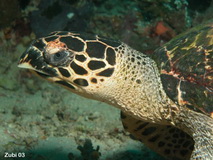
The hawksbill is a beautiful sea turtle. Its hard, top
shell, called the carapace, is made up of dark brown
or yellow and brown scales. These scales overlap like shingles on a roof. The
hawksbill's bottom shell is called the plastron. It is yellow. The skin of its
head and flippers has brown patches rimmed in yellow.
The hawksbill gets its name from its beak, because the top of it hooks down over
the lower part, much like the bill of a hawk.
This sea turtle measures a little less than three feet long and weighs a little
over one hundred pounds.
Hawksbills and other sea turtles have lungs andbreathe air.
Even though sea turtles can hold their breath for
many minutes, they must come up to breathe.
Hawksbills swim near coral reefs where they
find sponges, worms, fish, snails, and crabs to eat.
The Green Turtle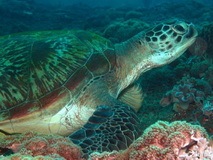
When western explorers began traveling to theAmericas and the Pacific, there
were millions of sea turtles in the seas. Traders, settlers, and pirates who
followed the European explorers soon found that one kind of sea turtle had
especially tasty meat. This turtle was brown all over, grew to about three feet
in length, and often weighed some 300 pounds.
It grazed in shallow beds of grass, or turtle grass, near the shore.Sailors
could easily capture the gentle animal. Theycould turn it over onto its back so
it was helpless, tie its flippers, and keep it aboard their ships to slaughter
when they needed fresh meat. The fat inside this turtle's body was green from
the grass it ate, so it was named the green turtle.
It is the only sea turtle that lives only on plants. Today, hundreds of years
later, green turtles are still hunted and taken.
The Loggerhead
The loggerhead turtle is slightly smaller than the green. A loggerhead may weigh
between 300 and 400 pounds.
It eats snails, clams, crabs, and other sea animals.
The loggerhead hunts near coral reefs and rocks. You can recognize it by its
large, thick head and broad, short neck.
The loggerhead, like other sea turtles, cannot pull its head into its shell the
way land turtles can. Its shell is like a suit of armor, but its head and
flippers are unprotected. Certain sharks may attack these parts, but the
loggerhead is big and fast and has few natural enemies. Color its carapace and
skin reddish-brown and the plastron yellow.

The Green Turtle Nesting
A
female green turtle arrived offshore at her nesting beach alone at night. She
had mated earlier with a male green turtle in the water nearby. It was time for
her to lay her eggs. She might nest three or four times during a single nesting
season. Though she is fast and well suited to the water, she is slow, awkward,
and in danger on land.
The female dragged herself out of the sea and onto the beach up beyond the reach
of high tide.
She dug a pit for her body with her flippers.
She nestled in it and used her back flippers, like shovels, to scoop out a
bottle-shaped hole.
Now she drops about one hundred white, leathery eggs that look like ping pong
balls into this hole.
When she finishes, she will cover the nest with sand and slowly go back to the
sea, leaving a trail behind her.
After she is gone, poachers may follow this trail and steal her eggs, or a
hungry animal may feast on them.
The Hatchlings
The rays of the sun heat the beach, warming the turtle's eggs buried in the
sand.
The eggs develop in the nest.
They are ready to hatch in about two months.
The hatchlings pick at their shells with a small, sharp point at the front of
their snout; this special part will disappear after hatching.
The hatchlings crack their shells. Many must hatch at almost the same time, so
they can share the work to escape from the nest. The baby turtles scrape away at
the sand overhead. The sand falls upon their empty egg shells, forming a
platform that allows the hatchlings to rise.
In a few days, they have scraped their way up to the roof of the nest. Then, at
night, or in the early morning, little dark heads and flippers wriggle out onto
the beach. Two-inch-long hatchlings crawl away and head to the sea.
Race to the Sea
The hatchlings sense the direction of the sea. The brightness over the water
attracts them. They crawl from the nest and begin their race to the sea. Full of
life, but defenseless, they struggle clumsily across the beach.
Their shells are soft and offer little protection.
In some places, lizards, crabs, or seabirds catch the tiny turtles and eat them.
Many of the hatchlings that make it to the water may be eaten by fish: snappers,
sharks, groupers, jacks, and sharp-toothed barracudas.
Only one or two of the hatchlings may live to adulthood. Where they go to spend
their first years of life is a mystery. It is one of nature's many secrets.
Green turtles, for example, are not seen again until they are several years old,
when they are found feeding offshore in turtle grass beds.
They are then as big as a dinner plate.

Where Sea Turtles Nest
Sea turtles nest in a wide, warm belt around the world. They all return to the
same beaches where they themselves hatched.
Each kind of sea turtle has its own special places.
Most Kemp's
ridleys
nest only on one beach on the northeast coast of Mexico (A).
The flatback
lays its eggs only on the coast of northern Australia (B). The flatback, as its
name suggests, has a flat carapace; it is somewhat smaller than the green turtle
and is gray in color.
Green turtles are found nesting in many places. Some green turtles migrate
thousands of miles to nest. Greens that feed in grassy beds off Brazil, for
example, may travel over 1,000 miles. They cross the Atlantic Ocean to return to
little Ascension Island (C) near Africa, where they were hatched. It is a wonder
that sea turtles seem to remember where they were born and that they have the
extraordinary ability to find these places again.
Sea Turtles? . . . Or Turtle Products?
Sea turtles are disappearing. And once they aregone, they will be gone forever.
One reason they are disappearing is because people use parts of turtles for food
and to make different products.
The hawksbill is prized for its carapace to make tortoiseshell combs, brush
handles, eyeglass frames, buttons, hair clips,and jewelry.
Some turtles are killed so they can be stuffed and hung on walls as decorations.
Green turtles are slaughtered for their meat and in order to make turtle soup.
The skin from the neck and flippers of greens and olive ridleys is made into
leather for purses and shoes.
Fat from turtle bodies is used in soaps and makeup creams. Other substances
should be used for these products.
In many countries it is now against the law to kill or harm sea turtles.

Turtle Hunting
People who live near the shore have always hunted sea turtles to help feed their
families. A fisherman might harpoon a sea turtle and take it home to eat.
Groups of men netted sea turtles when they rose to breathe and brought them back
to their villages for food.
For years, when sea turtles were plentiful, such hunting seemed to have little
effect on the numbers of turtles. But the demand for sea turtles kept growing.
Money could be earned hunting and selling sea turtles and things made from
turtles. Turtle hunting became profitable. So hunters took millions of turtles
in the sea and even on the land, when they were nesting.
Fewer and fewer sea turtles were left until they were almost gone in some
places. Laws now protect sea turtles and forbid trade in turtle products. But
not every country has these laws and not everyone obeys them.
Trawlers and Turtles
Commercial fishing boats around the world provide food from the sea for people.
These vessels cruise coastal waters, dragging large nets along the sea
bottom to gather in their catch.
Unfortunately, sea turtles are often caught accidentally in these nets. The
great funnel-shaped nets of shrimp trawlers, for example, trap many loggerhead,
Kemp's and olive ridley, and leatherback turtles. The turtles are swept along in
the nets with the shrimp.
They are not able to come up to the surface to breathe, and they drown.
Fortunately, a way has been found to solve the problem. Shrimp fishermen can use
turtle excluder devices or TEDs. TEDs are barriers that stop turtles from
getting stuck in nets. They let shrimp in while getting turtles out.
No Place to Nest
A
loggerhead turtle looks from the sea to a beach on the coast. Apartments,
houses, and hotels take up much of the beach. Only a narrow strip of sand
remains, and it is crowded with people. The turtle returns that night to nest.
Hundreds of lights shine out from windows. The beach is bright. The tide rises
to cement walls and pathways. There is no place for the turtle to nest.
Elsewhere, along the coast, another turtle finds a small, undeveloped piece of
beach and lays her eggs.
When they hatch, the young turtles crawl toward the brightness, but it is
not the sea. It is the light of street lamps along a road that passes nearby.
The hatchlings will die in the sun later that day.
Once there were many thousands of miles of open shore for sea turtles to nest on
safely. It is different
now.

Hope
for the Sea Turtle
Sea turtles can be saved, in spite of all the dangers they face. If enough
people care, if governments help, and if the efforts of conservationists
succeed, sea turtles will live.
Conservationists are people who study the problems of endangered animals or
plants and try to solve them.
The best conservation programs try not to interfere with turtles.
Sometimes,however, people have to interfere. In some places, sea turtle eggs are
moved away from egg collectors or animals that would destroy the nests.
After many years of protection, some sea turtle populations are increasing,
which is very good news.
Conservation programs are needed everywhere to
protect all the world's species of sea turtles. To make beaches
safe for little hatchlings, we can all work to keep them clean.

Lesson 9 TBA

Lesson 10 TBA

 CLICK
TO TO TO TOP CLICK
TO TO TO TOP 
|